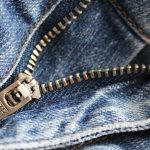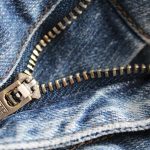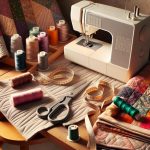Looking to start your sewing journey with some simple stitching techniques? When it comes to choosing the right fabric seams, finding the best ones for beginners can set the stage for your sewing success.
Understanding the basics of different seam types and their applications will help you craft clean and professional-looking garments. In this guide, you'll discover the most beginner-friendly fabric seams that will empower you to elevate your sewing skills.
Whether you're working on a garment or a craft project, mastering these essential seams will lay a strong foundation for your future sewing endeavors. Let's delve into the world of fabric seams and kickstart your sewing journey with confidence.
Key Takeaways
- Basic straight seam is a fundamental skill for beginners in sewing.
- Zigzag seam is versatile and durable, ideal for stretchy or woven fabrics.
- French seam provides a clean and polished finish, suitable for lightweight and heavy fabrics.
- Overlock seam is versatile for knit fabrics, prevents fraying, and gives a professional finish.
Basic Straight Seam
Start with a simple straight seam when you're just getting started with sewing. This fundamental skill sets the foundation for more complex techniques. Before you begin, ensure that your sewing machine is set up correctly. Familiarize yourself with the basics of your machine, such as threading the needle and winding the bobbin. If you encounter any issues, troubleshooting common sewing machine problems can save you time and frustration.
When it comes to fabric cutting techniques, accurate measurements are key. Use a clear ruler or measuring tape to mark the fabric. Double-check your measurements to avoid errors before cutting. Once you have your fabric prepared, align the edges carefully before sewing. Remember to backstitch at the beginning and end of your seam to secure the stitches in place.
As a beginner, mastering the straight seam will give you the confidence to tackle more intricate projects. Practice your fabric cutting techniques and familiarize yourself with your sewing machine to build a strong foundation for your sewing journey.
Zigzag Seam
Mastering the zigzag seam provides beginners with versatility and durability in their sewing projects. Unlike the basic straight seam, the zigzag seam offers more flexibility, making it ideal for stretchy or woven fabrics. One of the key advantages of the zigzag seam is its ability to prevent fraying, ensuring a neat and professional finish. Additionally, this seam type is perfect for creating decorative edges and adding a touch of creativity to your projects.
When it comes to zigzag seam alternatives and finishing techniques, consider using pinking shears to trim the seam allowance, which can help minimize fraying. Another option is to use a serger for a clean and professional finish on the edges of your fabric.
In addition to its versatility, the zigzag stitch has various applications, such as attaching elastic, sewing stretch fabrics, and creating buttonholes. However, beginners may encounter issues with skipped stitches or fabric bunching. To troubleshoot these problems, ensure that you're using the correct needle and thread for your fabric, and experiment with adjusting the stitch length and tension settings on your sewing machine. With practice, you'll master the zigzag seam and enhance your sewing repertoire.
French Seam
To achieve a clean and polished finish in your sewing projects, consider incorporating the French seam, which offers a professional and elegant look to your garment construction.
When comparing the French seam vs. mock French seam, it's important to note that the French seam is a true enclosed seam, while the mock French seam is a simpler version that mimics the look of a French seam but isn't as durable or professional.
Sewing different fabrics with French seams can be done with a few adjustments. For lightweight fabrics like chiffon or silk, trim the seam allowance to 1/8 inch after the first seam and then encase it with a 1/4 inch seam on the second pass. Heavier fabrics like denim may require wider seam allowances to accommodate the fabric thickness, but the French seam technique can still be applied effectively.
Flat-Felled Seam
You can easily create a durable and neat finish in your sewing projects by incorporating the flat-felled seam technique. This seam finishing method is commonly used in sturdy garments like jeans and workwear, as it provides strength and prevents fraying.
To create a flat-felled seam, start by sewing the seam with wrong sides together. Trim one side of the seam allowance, then fold the other side over it, encasing the raw edges. Topstitch along the folded edge to secure the seam in place. This creates a smooth, flat finish on the outside, with no raw edges visible inside the garment.
When using the flat-felled seam, consider using a sturdy thread and a longer stitch length to ensure the seam's strength. If your sewing machine has a special presser foot for flat-felled seams, use it to achieve precise and even topstitching. Additionally, be mindful of the fabric thickness and adjust your machine's settings accordingly. Troubleshooting tip: if the fabric puckers during topstitching, try using a walking foot to feed the layers evenly through the machine.
Incorporating flat-felled seams in your sewing projects offers a professional and polished look. With the right techniques and attention to detail, you can master this seam finishing method and explore various topstitching options to enhance your creations.
Overlock Seam
So, you've heard about the overlock seam and want to learn more about it. Well, you're in the right place!
Let's talk about the overlock stitch, the benefits it offers, and some essential tips for mastering the overlock seam.
Overlock Stitch Explained
The overlock stitch is a versatile and essential seam for beginners learning to sew with knit fabrics. It not only provides a neat and professional finish but also prevents the edges of the fabric from fraying.
When using an overlock stitch, it's important to adjust the sewing machine tension to ensure that the threads interlock properly without causing any puckering or stretching of the fabric. Additionally, choosing the right thread types is crucial for achieving a strong and durable overlock seam. Polyester or cotton-wrapped polyester threads are commonly recommended for overlock stitching due to their elasticity and strength.
Benefits of Overlocking
Mastering the overlock seam provides beginners with a durable and professional finish, preventing fraying and enhancing the overall quality of your sewing projects.
Here are three key benefits of overlocking:
- Stitch types: Overlocking allows you to create various stitch types such as a standard overlock, flatlock, or rolled hem, adding versatility to your sewing projects.
- Thread tension: Overlocking helps you understand and adjust thread tension, resulting in strong, secure seams that withstand wear and tear.
- Professional finish: Overlock seams give your creations a polished, neat appearance, elevating the overall quality of your work and providing a clean edge that's less likely to unravel.
Mastering overlocking not only improves the durability of your projects but also enhances their visual appeal, making it an essential skill for any sewing enthusiast.
Overlock Seam Tips
For beginners, mastering the overlock seam involves understanding its key features and implementing these tips for achieving professional results.
When using a serger for fabric edge finishing, it's crucial to troubleshoot common sewing machine issues like thread breakage or skipped stitches. Ensure that the tension is correctly adjusted to prevent fabric puckering or stretching.
Additionally, mastering serger techniques such as differential feed settings can help achieve smooth and even seams on different types of fabric. Understanding the stitch width and length settings on your serger is also essential for achieving the desired seam appearance.
Mock French Seam
If you're new to sewing, try using the mock French seam for a clean and professional finish on lightweight fabrics. This technique not only provides a decorative finish but is also beginner-friendly, making it an excellent choice for those who are just starting out.
Here are three reasons why the mock French seam is a great option for beginners:
- Professional Look: The mock French seam gives your project a neat and tidy appearance, perfect for garments and home decor items made from delicate fabrics like chiffon, georgette, or organza.
- Easy to Master: Unlike traditional French seams, the mock French seam is simpler to execute, making it ideal for beginners. With a few basic sewing skills, you can achieve a polished look without feeling overwhelmed.
- Versatile Application: This seam finish can be used on a variety of lightweight fabrics, allowing you to elevate the overall quality of your sewing projects. Whether you're creating blouses, dresses, or curtains, the mock French seam adds a touch of sophistication.
Double-Stitched Seam
When you're looking for a strong and durable seam, the double-stitched seam is a great choice.
Not only does it provide extra strength, but it also gives your project a professional and polished appearance.
What's more, it's versatile and works well with various types of fabrics, making it a practical option for beginners and seasoned sewers alike.
Strength and Durability
When learning to sew, you should consider using the double-stitched seam for its exceptional strength and durability. This type of seam is ideal for heavy fabrics and items that will undergo a lot of wear and tear. Here's why the double-stitched seam is a great choice:
- Reinforcement: The extra row of stitching in a double-stitched seam provides added reinforcement, making it perfect for items like bags, jeans, and upholstery.
- Stress points: Double-stitched seams are excellent for reinforcing stress points on garments or items that will be subjected to frequent pulling and stretching.
- Longevity: The durability of the double-stitched seam ensures that your creations will last longer, making it a reliable choice for projects that require extra strength and sturdiness.
Professional and Polished
To achieve a professional and polished look with your sewing projects, you can utilize the double-stitched seam. This seam finishing technique offers exceptional strength and durability for heavy fabrics and items that will undergo a lot of wear and tear.
The double-stitched seam involves sewing the seam with two lines of stitching, providing added security and a neat, refined appearance. When executing this technique, it is important to ensure that your sewing machine is set to the appropriate stitch length and tension. This will prevent any puckering or bunching of the fabric.
In addition to setting your machine correctly, it is also crucial to press the seam allowances open and flat. This step will create a smooth and professional finish. By mastering the double-stitched seam, you can elevate the quality of your projects, making them appear expertly crafted and enduring.
Versatile for Various Fabrics
The double-stitched seam is a versatile choice for various fabrics, offering exceptional strength and durability. When working with different fabric types, the double-stitched seam proves to be reliable for a wide range of applications, from lightweight cotton to heavy denim. Its adaptability makes it an ideal option for creating sturdy hems or reinforcing seams on diverse materials.
Additionally, mastering stitching techniques like adjusting thread tension and using the correct needle size is crucial for achieving a professional finish. Understanding common troubleshooting issues, such as skipped stitches or puckering, empowers you to tackle challenges confidently.
With the double-stitched seam, you can confidently approach various fabrics and applications, knowing that you have a robust and adaptable technique at your disposal.
Bias Bound Seam
You can create a bias bound seam by encasing the raw edge of the fabric with bias tape, providing a clean and professional finish. Bias binding techniques are ideal for finishing edges and creating clean, neat edges with bias binding. The bias bound seam is especially useful for curved or round edges as it allows the fabric to stretch and curve without puckering or bunching. The following table outlines the key advantages of using bias bound seams:
| Advantages of Bias Bound Seams | |
|---|---|
| Provides a clean and professional finish | |
| Ideal for curved or round edges | |
| Prevents puckering or bunching | |
| Allows fabric to stretch and curve | |
| Versatile for various fabrics |
Bias bound seams are a great addition to your sewing skills, offering a polished look to your projects. Mastering bias binding techniques will give you the confidence to work with a wide range of fabrics and create beautifully finished edges. Whether you're sewing garments, quilts, or home decor items, mastering the bias bound seam will elevate the quality of your work.
Frequently Asked Questions
What Are the Most Common Mistakes Beginners Make When Sewing Basic Straight Seams?
When sewing basic straight seams, common mistakes include uneven stitching, fabric puckering, and not backstitching. Troubleshooting techniques involve checking thread tension and using the right needle. Beginner tips include practicing on scrap fabric and mastering seam finishing techniques.
Are There Any Special Techniques or Tools Needed to Create a Flat-Felled Seam?
To create a flat-felled seam, you'll need specialized tools like a felling foot and proper seam allowance. This technique prevents fabric fraying and adds strength. Avoid common sewing mistakes by mastering this seam creativity with precise stitching.
Can a Zigzag Seam Be Used on All Types of Fabric, or Are There Certain Materials It Works Better With?
When using a zigzag seam, it's important to consider fabric compatibility. For beginners, common mistakes include using this seam on stretchy fabrics without adjusting the stitch width. Take care when choosing fabric for this seam.
What Are Some Creative Ways to Use Bias Bound Seams in Sewing Projects?
When working on creative projects, bias tape can be used in various sewing techniques to add unique fabric finishes. Explore using bias bound seams to create decorative edges, finish raw edges, or add colorful accents to your sewing projects.
Are There Any Tips for Preventing Fabric From Fraying When Using an Overlock Seam?
To prevent fraying, use overlock seam techniques. Trim the fabric edges first, then stitch with a narrow overlock, adjusting tension for a clean finish. Secure loose threads and use fabric fray prevention products for added durability.
- Choosing the Right Fabrics for Babies - July 20, 2024
- Impact of Fabrics on Skin Health - July 20, 2024
- Benefits of Antimicrobial Fabrics - July 20, 2024







